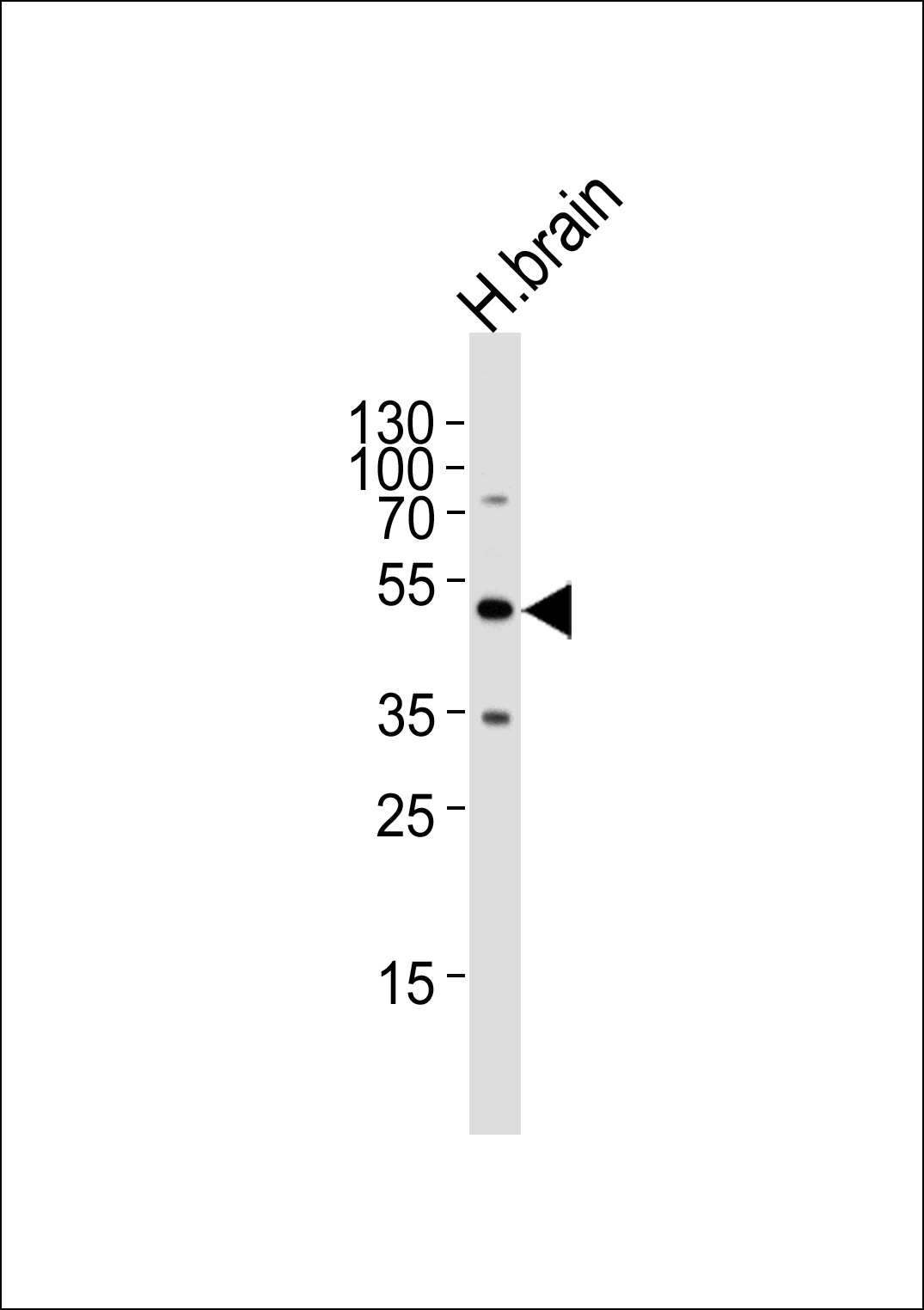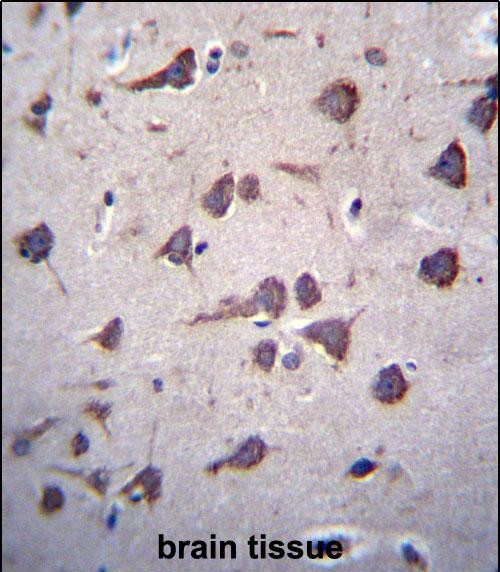FKTN Antibody (Center)
Affinity Purified Rabbit Polyclonal Antibody (Pab)
- SPECIFICATION
- CITATIONS
- PROTOCOLS
- BACKGROUND

Application
| WB, IHC-P, E |
|---|---|
| Primary Accession | O75072 |
| Other Accession | Q60HG0, NP_001073270.1, NP_006722.2 |
| Reactivity | Human |
| Predicted | Monkey |
| Host | Rabbit |
| Clonality | Polyclonal |
| Isotype | Rabbit IgG |
| Calculated MW | 53724 Da |
| Antigen Region | 177-206 aa |
| Gene ID | 2218 |
|---|---|
| Other Names | Fukutin, 2---, Fukuyama-type congenital muscular dystrophy protein, FKTN, FCMD |
| Target/Specificity | This FKTN antibody is generated from rabbits immunized with a KLH conjugated synthetic peptide between 177-206 amino acids from the Central region of human FKTN. |
| Dilution | WB~~1:1000 IHC-P~~1:10~50 E~~Use at an assay dependent concentration. |
| Format | Purified polyclonal antibody supplied in PBS with 0.09% (W/V) sodium azide. This antibody is purified through a protein A column, followed by peptide affinity purification. |
| Storage | Maintain refrigerated at 2-8°C for up to 2 weeks. For long term storage store at -20°C in small aliquots to prevent freeze-thaw cycles. |
| Precautions | FKTN Antibody (Center) is for research use only and not for use in diagnostic or therapeutic procedures. |
| Name | FKTN (HGNC:3622) |
|---|---|
| Function | Catalyzes the transfer of a ribitol-phosphate from CDP- ribitol to the distal N-acetylgalactosamine of the phosphorylated O- mannosyl trisaccharide (N-acetylgalactosamine-beta-3-N- acetylglucosamine-beta-4-(phosphate-6-)mannose), a carbohydrate structure present in alpha-dystroglycan (DAG1) (PubMed:26923585, PubMed:27194101, PubMed:29477842). This constitutes the first step in the formation of the ribitol 5-phosphate tandem repeat which links the phosphorylated O-mannosyl trisaccharide to the ligand binding moiety composed of repeats of 3-xylosyl-alpha-1,3-glucuronic acid-beta-1 (PubMed:17034757, PubMed:25279699, PubMed:26923585, PubMed:27194101, PubMed:29477842). Required for normal location of POMGNT1 in Golgi membranes, and for normal POMGNT1 activity (PubMed:17034757). May interact with and reinforce a large complex encompassing the outside and inside of muscle membranes (PubMed:25279699). Could be involved in brain development (Probable). |
| Cellular Location | Golgi apparatus membrane; Single-pass type II membrane protein. Cytoplasm {ECO:0000250|UniProtKB:Q8R507}. Nucleus {ECO:0000250|UniProtKB:Q8R507}. Note=In retinal tissue, does not localize with the Golgi apparatus. {ECO:0000250|UniProtKB:Q8R507} |
| Tissue Location | Expressed in the retina (at protein level) (PubMed:29416295). Widely expressed with highest expression in brain, heart, pancreas and skeletal muscle (PubMed:11115853). Expressed at similar levels in control fetal and adult brain (PubMed:11115853) Expressed in migrating neurons, including Cajar-Retzius cells and adult cortical neurons, as well as hippocampal pyramidal cells and cerebellar Purkinje cells (PubMed:11115853). No expression observed in the glia limitans, the subpial astrocytes (which contribute to basement membrane formation) or other glial cells (PubMed:11115853) |

Thousands of laboratories across the world have published research that depended on the performance of antibodies from Abcepta to advance their research. Check out links to articles that cite our products in major peer-reviewed journals, organized by research category.
info@abcepta.com, and receive a free "I Love Antibodies" mug.
Provided below are standard protocols that you may find useful for product applications.
Background
The protein encoded by this gene is a putative transmembrane protein that is localized to the cis-Golgi compartment, where it may be involved in the glycosylation of alpha-dystroglycan in skeletal muscle. The encoded protein is thought to be a glycosyltransferase and could play a role in brain development. Defects in this gene are a cause of Fukuyama-type congenital muscular dystrophy (FCMD), Walker-Warburg syndrome (WWS), limb-girdle muscular dystrophy type 2M (LGMD2M), and dilated cardiomyopathy type 1X (CMD1X). Alternatively spliced transcript variants have been found for this gene.
References
Lim, B.C., et al. Neuromuscul. Disord. 20(8):524-530(2010)
Saredi, S., et al. Muscle Nerve 39(6):845-848(2009)
Chang, W., et al. Prenat. Diagn. 29(6):560-569(2009)
Mercuri, E., et al. Neurology 72(21):1802-1809(2009)
Puckett, R.L., et al. Neuromuscul. Disord. 19(5):352-356(2009)
If you have used an Abcepta product and would like to share how it has performed, please click on the "Submit Review" button and provide the requested information. Our staff will examine and post your review and contact you if needed.
If you have any additional inquiries please email technical services at tech@abcepta.com.













 Foundational characteristics of cancer include proliferation, angiogenesis, migration, evasion of apoptosis, and cellular immortality. Find key markers for these cellular processes and antibodies to detect them.
Foundational characteristics of cancer include proliferation, angiogenesis, migration, evasion of apoptosis, and cellular immortality. Find key markers for these cellular processes and antibodies to detect them. The SUMOplot™ Analysis Program predicts and scores sumoylation sites in your protein. SUMOylation is a post-translational modification involved in various cellular processes, such as nuclear-cytosolic transport, transcriptional regulation, apoptosis, protein stability, response to stress, and progression through the cell cycle.
The SUMOplot™ Analysis Program predicts and scores sumoylation sites in your protein. SUMOylation is a post-translational modification involved in various cellular processes, such as nuclear-cytosolic transport, transcriptional regulation, apoptosis, protein stability, response to stress, and progression through the cell cycle. The Autophagy Receptor Motif Plotter predicts and scores autophagy receptor binding sites in your protein. Identifying proteins connected to this pathway is critical to understanding the role of autophagy in physiological as well as pathological processes such as development, differentiation, neurodegenerative diseases, stress, infection, and cancer.
The Autophagy Receptor Motif Plotter predicts and scores autophagy receptor binding sites in your protein. Identifying proteins connected to this pathway is critical to understanding the role of autophagy in physiological as well as pathological processes such as development, differentiation, neurodegenerative diseases, stress, infection, and cancer.



